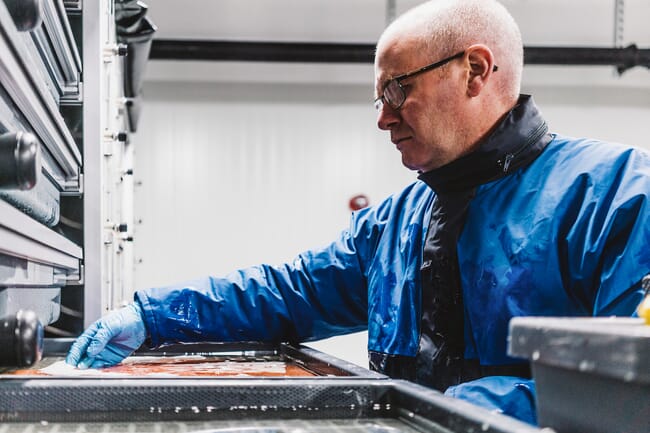
The unit is set to improve fish health and welfare by allowing the eggs to be incubated at a lower temperature © Scottish Sea Farms
Currently, the company receives fertilised eggs that have developed to the eyed stage from its specialist suppliers, but construction of the new incubation unit adjacent to the main hatchery at Barcaldine means that SSF will soon be able to receive eggs immediately after stripping their broodstock and then fertilise them on-site.
This means they can be incubated through the most fragile stages of their development until robust enough to be transferred to one of the company’s three hatcheries: Barcaldine itself, Knock on the Isle of Mull, or Girlsta in Shetland.
“What we’re doing is creating a bespoke facility that will allow us to have greater control of the eggs even earlier in the production cycle,” SSF head of freshwater, Rory Conn, told company newsletter, The Source.
“We’ll be able to take our time through these most critical initial stages, incubating the eggs for longer and at lower temperatures as we deem appropriate," he added.
Emerging research suggests that incubating eggs at lower temperatures during the very early stages can have better outcomes for fish health later in life, particularly with regards to cardiac health.
“We would be looking to incubate as low as possible, likely 2-3°C, to encourage the slow and steady development of the ova,” said Conn.
By receiving eggs immediately post-stripping, SSF’s freshwater team will also have greater influence over another key welfare factor – water quality.
“Exposure to clean water is hugely important and we’re very confident of our water quality here at Barcaldine,” said Conn.
“Equipped with the most sophisticated recirculating aquaculture system (RAS) of its kind in Scotland, the main hatchery draws in freshwater from the nearby Gleann Dubh reservoir and puts it through a complex system of filters and UV light to remove anything greater than 0.01 microns (0.00001mm) and ensure that no bacteria or viruses can get through.
“Within the new unit, there will be three similar RAS setups, supplying water to the racks where the new eggs are housed. Any one of the racks can be supplied by an individual RAS set-up so we can supply them all at different temperatures should we choose to – the importance being that it gives us control over how quickly or otherwise the ova develops. And because the water is so clean, it’s as safe as it can possibly be for the ova.”
Once the eggs reach the eyed stage, they will go through a quality checking process to ensure that only the viable are transferred to incubation trays.
“The priority with this latest investment in our freshwater farming is to secure the supply and quality of our ova and provide the capacity for optimal incubation, from fertilisation onwards,” said Conn.
“Initially, we’ll fertilise only a proportion of our ova supply on-site. However, the unit has the capacity to accommodate all our current and future ova requirements," he added.
